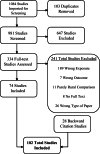Urban Scaling of Health Outcomes: a Scoping Review
- PMID: 35513600
- PMCID: PMC9070109
- DOI: 10.1007/s11524-021-00577-4
Urban Scaling of Health Outcomes: a Scoping Review
Abstract
Urban scaling is a framework that describes how city-level characteristics scale with variations in city size. This scoping review mapped the existing evidence on the urban scaling of health outcomes to identify gaps and inform future research. Using a structured search strategy, we identified and reviewed a total of 102 studies, a majority set in high-income countries using diverse city definitions. We found several historical studies that examined the dynamic relationships between city size and mortality occurring during the nineteenth and early twentieth centuries. In more recent years, we documented heterogeneity in the relation between city size and health. Measles and influenza are influenced by city size in conjunction with other factors like geographic proximity, while STIs, HIV, and dengue tend to occur more frequently in larger cities. NCDs showed a heterogeneous pattern that depends on the specific outcome and context. Homicides and other crimes are more common in larger cities, suicides are more common in smaller cities, and traffic-related injuries show a less clear pattern that differs by context and type of injury. Future research should aim to understand the consequences of urban growth on health outcomes in low- and middle-income countries, capitalize on longitudinal designs, systematically adjust for covariates, and examine the implications of using different city definitions.
Keywords: City growth; City size; Complex systems; Urban health; Urban scaling; Urbanization.
© 2022. The Author(s).
Conflict of interest statement
The authors declare no competing interests.
Figures


Similar articles
-
Urban scaling of health outcomes: a protocol for a scoping review.BMJ Open. 2019 Nov 24;9(11):e031176. doi: 10.1136/bmjopen-2019-031176. BMJ Open. 2019. PMID: 31767587 Free PMC article.
-
The economics of urban size.Pap Reg Sci Assoc. 1971;26:67-83. doi: 10.1111/j.1435-5597.1971.tb01493.x. Pap Reg Sci Assoc. 1971. PMID: 12312621
-
Scaling of Chinese urban CO2 emissions and multiple dimensions of city size.Sci Total Environ. 2023 Jan 20;857(Pt 2):159502. doi: 10.1016/j.scitotenv.2022.159502. Epub 2022 Oct 17. Sci Total Environ. 2023. PMID: 36265639
-
The economics of healthcare access: a scoping review on the economic impact of healthcare access for vulnerable urban populations in low- and middle-income countries.Int J Equity Health. 2022 Dec 31;21(1):191. doi: 10.1186/s12939-022-01804-3. Int J Equity Health. 2022. PMID: 36585704 Free PMC article.
-
Unplanned urbanization and health risks of Dhaka City in Bangladesh: uncovering the associations between urban environment and public health.Front Public Health. 2023 Oct 19;11:1269362. doi: 10.3389/fpubh.2023.1269362. eCollection 2023. Front Public Health. 2023. PMID: 37927876 Free PMC article. Review.
Cited by
-
Scaling of cardiovascular risk factors in 230 Latin American cities.Sci Rep. 2025 Mar 1;15(1):7279. doi: 10.1038/s41598-025-92087-5. Sci Rep. 2025. PMID: 40025192 Free PMC article.
-
Associations between gun violence exposure and suicide mortality rates in US counties.Soc Psychiatry Psychiatr Epidemiol. 2025 Mar;60(3):719-725. doi: 10.1007/s00127-024-02771-6. Epub 2024 Sep 28. Soc Psychiatry Psychiatr Epidemiol. 2025. PMID: 39340546
-
Differential Mortality Trends at the Intersection of Climate Change and Urban Growth From 13th to 18th Century Berlin.Am J Biol Anthropol. 2025 Jun;187(2):e70071. doi: 10.1002/ajpa.70071. Am J Biol Anthropol. 2025. PMID: 40546124 Free PMC article.
-
Exploring inequalities in life expectancy and lifespan variation by race/ethnicity and urbanicity in the United States: 1990 to 2019.SSM Popul Health. 2022 Sep 13;19:101230. doi: 10.1016/j.ssmph.2022.101230. eCollection 2022 Sep. SSM Popul Health. 2022. PMID: 36148325 Free PMC article.
-
Scaling law characteristics and spatiotemporal multicomponent analysis of syphilis from 2016 to 2022 in Zhejiang Province, China.Front Public Health. 2023 Oct 25;11:1275551. doi: 10.3389/fpubh.2023.1275551. eCollection 2023. Front Public Health. 2023. PMID: 37965512 Free PMC article.
References
-
- Ritchie H, Roser M. Urbanization. Our World in Data. 2018;
-
- Satterthwaite D. A new urban agenda? London: SAGE Publications Sage UK; 2016.
-
- West GB. Scale: the universal laws of growth, innovation, sustainability, and the pace of life in organisms, cities, economies, and companies. New York: Penguin; 2017.

